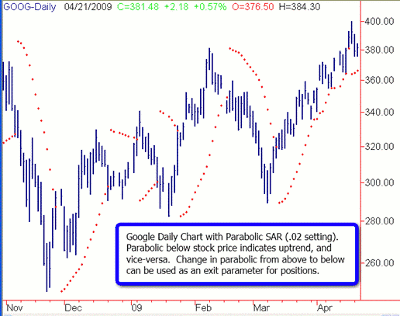Price Headley profiles the Parabolic SAR indicator, a method invented by legendary technician Welles Wilder as a means of identifying important trend changes in individual stocks.
Let's begin this discussion with a basic definition of a parabola. According to good old Merriam and Webster's Dictionary, a parabola is a "plane curve generated by a point moving so that its distance from a fixed point is equal to its distance from a fixed line; the intersection of a right circular cone with a plane parallel to an element of the cone; something bowl shaped."
The parabolic indicator we will discuss here is a strategy utilizing what many call a "stop-and-reversal" (SAR) method, which earns this indicator the name "Parabolic SAR." Parabolic SAR is available on most trading platforms these days.
Parabolic SAR was created by Welles Wilder, a name well known to technical analysts because he also created Relative Strength Index (RSI) and Directional Movement Indicator (DMI). This indicator is used to establish trailing price stops for either long or short positions.
Note, however, that this indicator was designed to be used to establish stops rather than discerning a stock's direction or trend. Welles intended that the equity's trend should be determined first, and then used the Parabolic SAR to trade in the direction of the established trend.
At the beginning of the trend, the Parabolic SAR will generally show a greater distance between the price and the trailing stop. As the stock furthers its trend, the distance between the stock's price and the indicator will lessen; therefore, the stop-loss will diminish.
What does the Parabolic SAR look like? It is the red dotted line overlaid on this daily chart from 2009 of Google (GOOG) below (which can still be useful in the hypothetical):
See how the dotted line tracks along with the stock? That is the nature of the Parabolic SAR. One use of this indicator is when the stock's price crosses above or below the parabolic line itself to signal a potential buy or sell set-up.
At BigTrends.com, we often incorporate parabolics into trading screens and systems as a confirmation of a trend or an indication of a trend ending/reversing. It is often useful as a factor built into the exit side of a trading system.
As with most technical indicators, combining parabolics with other indicators can lead to a powerful trading tools, screens, and systems. Test different methods, techniques, and inputs on trading software like MetaStock or TradeStation in order to supercharge your trading.
By Price Headley of BigTrends.com

















